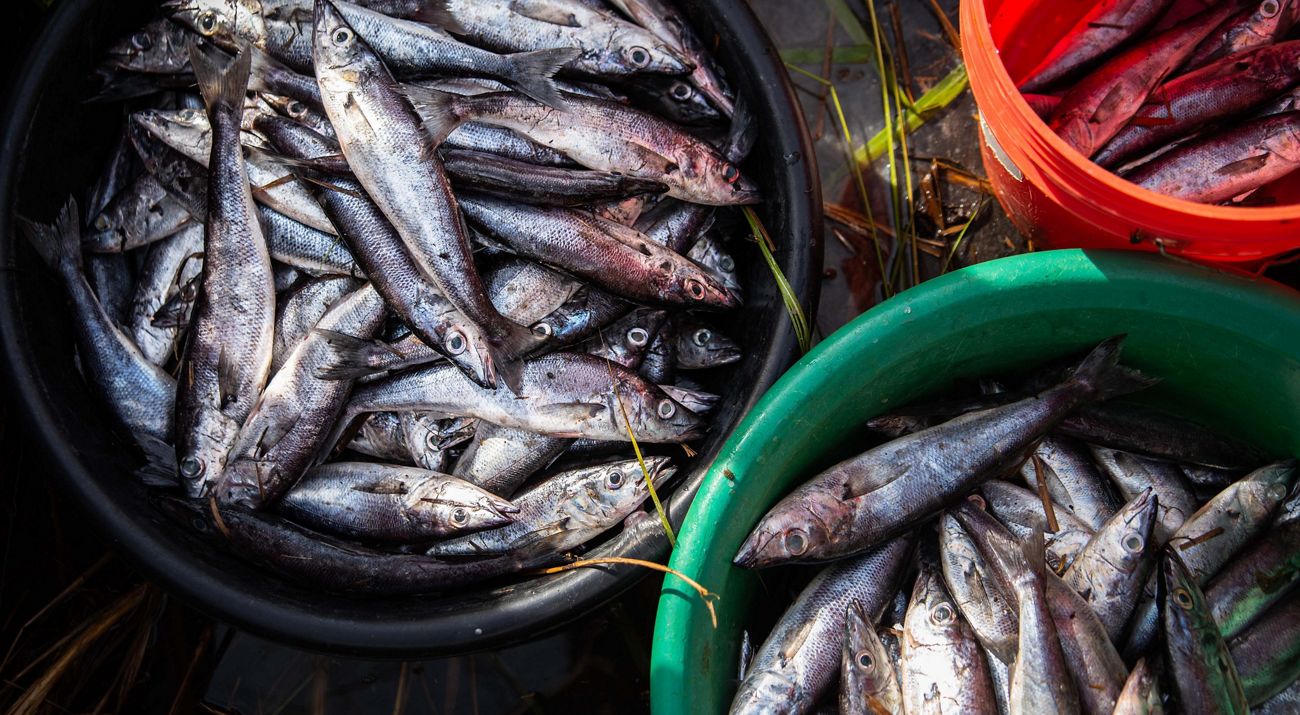
Community-Led Conservation of Freshwater and Fisheries in Africa
Meet the communities that are stewarding global freshwater ecosystems for nature and people.
In Africa, our Community-Led Conservation of Freshwater and Fisheries work focuses on the Bas Ogooué wetland and riverine region in Gabon; the Kavango Zambezi Transfrontier Conservation (KAZA) Area of Southern Africa, with a focus on the Kafue-West Lunga Landscape in Zambia and the upper catchment of the Okavango Basin in Angola; and Lake Tanganyika, which is bordered by Tanzania, Zambia, the Democratic Republic of the Congo and Burundi.
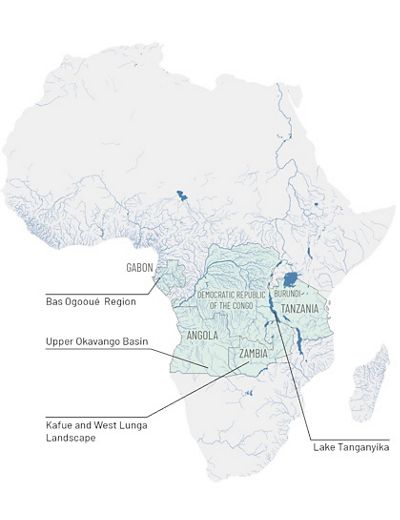
Projects listed include the Bas Ogooué Region, the Upper Okavango Basin, the Kafue and West Lunga Landscape, and Lake Tanganyika.
Each of these areas are unique freshwater ecosystems where community-led conservation can benefit both nature and people.
Across these geographies, we co-create solutions with on-the-ground partners—like implementing sustainable fisheries management practices and equipping communities with the tools they need to restore the overall health of their local freshwater ecosystems.
With partners, we’re investing in the future of these communities by supporting the development of new sustainable financing mechanisms that can help pay for continued conservation activities and by helping diversify income streams to alleviate pressure on natural resources while improving livelihoods.
Through our work, we’re proving the ecological and economic benefits of community-led conservation of freshwater and fisheries and laying the groundwork for its application across the continent.
Read more about our work across Africa in our Africa 2024 Year in Review.
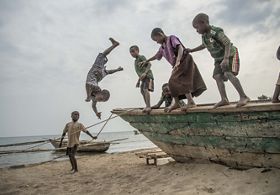
Listen to the sounds of local children playing on the shore of Lake Tanganyika.
Upper Okavango Basin
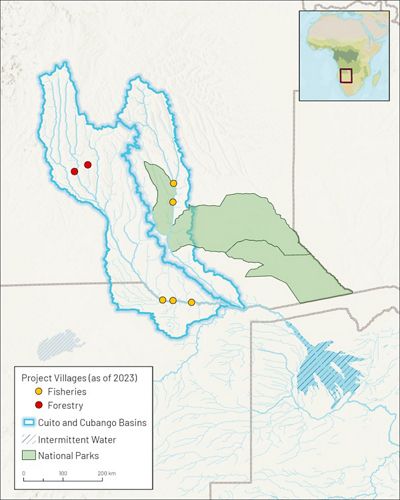
This map highlights project villages as of 2023 for fisheries and forestry. It also depicts the outlines of the Cuito and Cubango Basins, as well as areas of intermittent water and national parks.
A closer look: Upper Okavango
-
Cuando and Cubango Provinces, Angola
-
2018
-
- An important local food and income source, the African tigerfish is a popular sportfish and a top freshwater predator
- Tilapia
- Catfish
-
- Depleted fish stocks
- Land use practices that threaten water quality and quantity
- Hydropower dam development and altered flows to the Delta
- Lack of law enforcement
- Low level of literacy
- Acute poverty
-
- Reduce fishing pressure on fish breeding sites by protecting source waters
- Supporting community-led fisheries and forest management
- Providing science to support decision-making
- Alternative livelihood options
- Capacity-building
- Government and key stakeholders continuous buy-in
-
- Local and traditional communities and organizations
- Associação de Conservação do Ambiente e Desenvolvimento Integrado Rural (ACADIR)
- Angolan government
- National Geographic Okavango Wilderness Project
- World Wildlife Fund
- Ajuda de Desenvolvimento de Povo para Povo (ADPP)
- Missão de Beneficência Agropecuária do Kubango, Inclusão, Tecnologias e Ambiente (Mbakita)
- Lisima Foundation
- The Halo Trust
- Namibia Nature Foundation
-
- 2019 article: Okavango Basin: Protecting Africa’s Seasonal Oasis (nature.org)
- 2021 article: The Okavango Delta: An African Oasis (nature.org)
- TNC in Angola and Botswana: Angola and Botswana | The Nature Conservancy
Planning Sustainable Development for Nature and People
Fed by seasonal rains in Angola’s highlands, the Okavango River meanders more than 1,700 kilometers south through Angola and Namibia before reaching its terminus in Botswana. Unlike many river systems, these waters never reach the sea.
Instead, the river empties into an interior floodplain called the Okavango Delta, which supports an abundance of life, including hippopotamus, big cats and Africa’s largest population of savanna elephants. The river basin directly sustains more than 1 million people who depend on it for drinking, fishing, forestry, agriculture and tourism.
While the Okavango Delta is largely protected (it is one of the largest Ramsar Wetlands of International Importance in the world), much of the headwaters that provide water to the Delta are not. Encroaching development and other pressures now put the entire Okavango River system at risk.
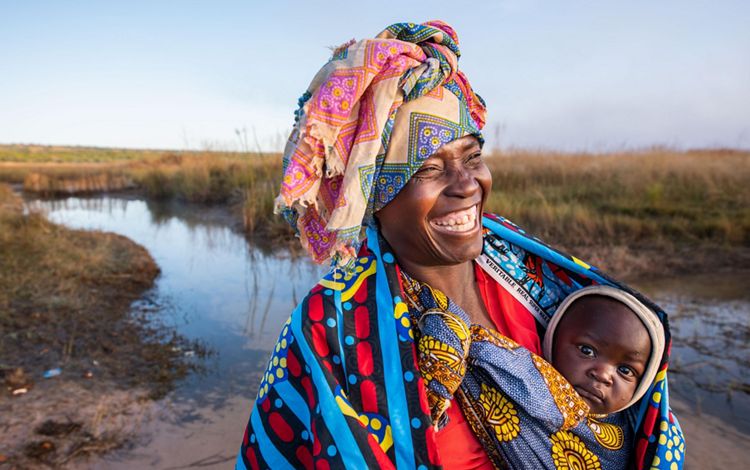
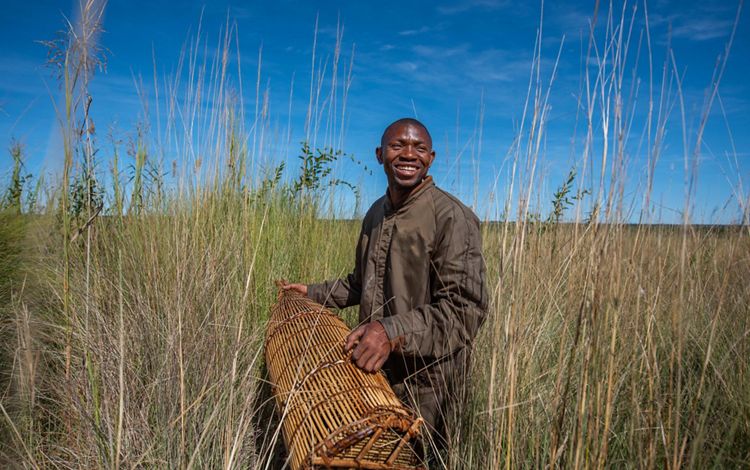
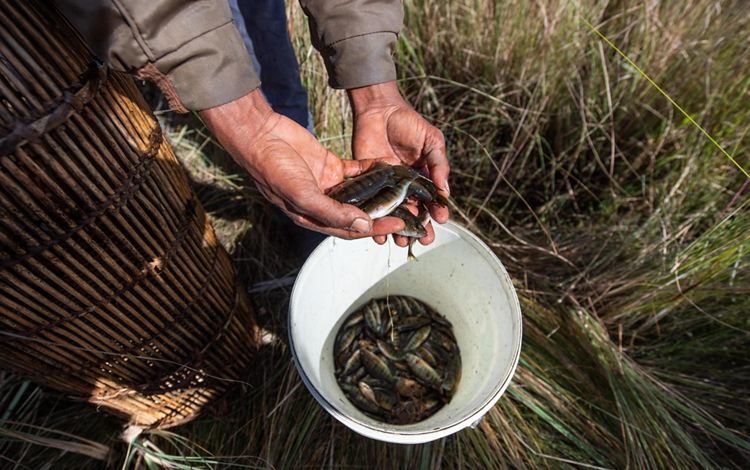
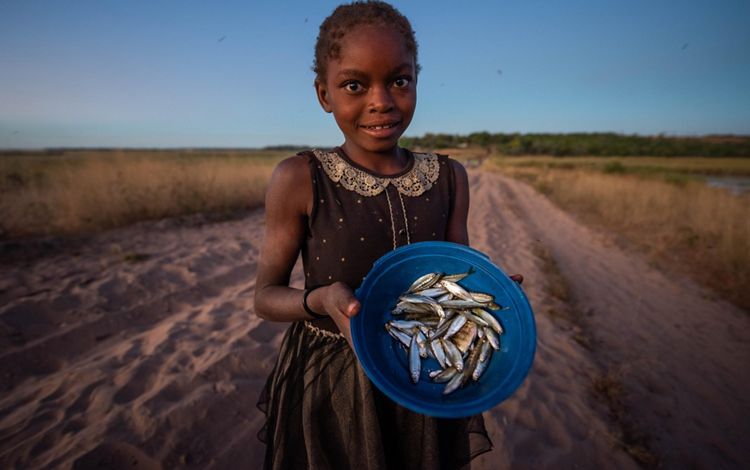
The Challenge
The Upper Okavango Basin remains largely pristine today due in part to a history of civil war that ravaged the landscape and subsequently prevented people from populating the area.
But more than 20 years after the war, Southeast Angola is on the verge of rapid development. If not managed correctly, the people and animals that depend on this irreplaceable landscape may face resource depletion and degraded water quality and quantity. The critical timing of upstream water reaching the Delta could also be compromised, further disrupting ecosystem balance.
The Opportunity
For now, opportunities to invest in the Upper Okavango Basin’s preservation and promote sustainable development for the region both still exist. But time is running out.
Increased investment in community-led conservation of freshwater and fisheries offers a clear pathway to success.
“People are dependent on natural resources. We want to help them take full ownership of these resources, manage them and also derive a livelihood,” said TNC’s Okavango Basin Program Director, Sekgowa Motsumi.
TNC and partners are implementing pilot projects in thirteen villages in Angola’s Okavango headwaters. In Livambi, Liavela, Mangondo, Situtume and Kambumbu/Sihugongo, Ndumba and Kambamba projects primarily address challenges with fisheries. In the villages of Luassenha, Liaconga, Cambungu, Lilambo, Malengue and Lievela, project efforts are focused on forest management.
Partnership in Action
TNC’s greatest successes in the region have grown from an enduring partnership with Associação de Conservação do Ambiente e Desenvolvimento Integrado Rural (ACADIR), a local organization that is deeply connected to the history of the area. Its leader, Antonio Chipita, survived the Angolan Civil War and has managed ACADIR for more than 20 years, building deep trust with the local communities that call the basin home.
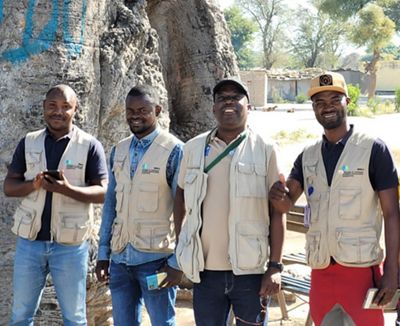
TNC is also strengthening its partnership with (Ajuda de Desenvolvimento de Povo para Povo) ADPP an NGO that has operated in Angola in close collaboration with the government for more than 20 years. ADPP is involved in various themes from environmental issues, biodiversity, education, health, Water, sanitation and hygiene (WASH), etc.
In addition, TNC is strengthening the technical and institutional capacity of Mbakita a local NGO.
TNC, partners and local communities are working to:
- Create a framework for both land and freshwater that will inform community conservation planning;
- Effectively use the first comprehensive hydrologic model of the Okavango’s upper catchment that TNC developed with partners for resource conservation and management planning;
- Identify energy alternatives to proposed hydropower projects that will meet the energy needs of southeast Angola while safeguarding their freshwater resources.
Looking Forward
At TNC, our 2030 goals guide our efforts and unite programs across the organization. In the Okavango, by 2030, we will improve management of 5% of the Cuito and Cubango River floodplains, avoid impacts on 5,000 hectares in the Okavango delta and protect 60 kilometers of river systems. We will improve the decision-making over lands, waters, or resources for more than 1,000 people in local communities.
Zambia
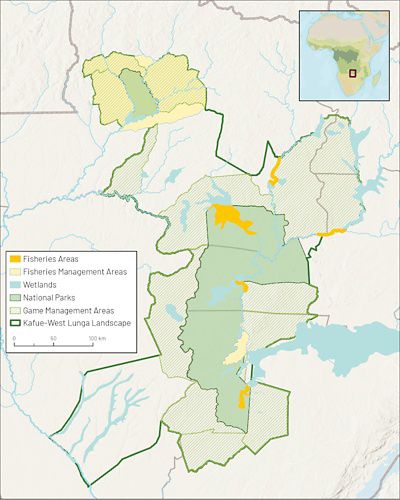
This map of freshwater fisheries projects in Zambia highlights fisheries areas, fisheries management areas, wetlands, national parks, game management areas, and the location of the Kafue-West Lunga Landscape.
A closer look: Zambia
-
Kafue-West Lunga Landscape, Zambia
-
2013
-
More than 100 freshwater fish species reside in the Kafue-West Lunga Landscape.
-
- Overfishing and unsustainable fishing methods
- Unregulated and unreported fishing
- Discarded gear that traps animals (ghost fishing)
-
- Advance security of access, tenure & fisheries co-management rights for local communities
- Improve governance & management of fisheries
- Develop & deploy socio-ecological research & monitoring plans that inform conservation intervention priorities & fishery status
- Investigate opportunities for freshwater protection
- Assess opportunities for fisheries development and optimization
-
- Local communities
- Zambia Department of Fisheries
- African Parks Network
- Aquatic Ecosystem Services
- Mushingashi Conservancy
-
2018 TNC Article: Stunning photos from Zambia’s forest community
Conservation Landscapes Support Thriving Fisheries
Zambia’s 10-million-hectare Kafue-West Lunga Landscape spans the West Lunga and Kafue National Parks and the surrounding community conservation areas. A tangle of rivers, lakes and wetlands weaves across the conservation landscape supporting valuable community-led fisheries and globally significant freshwater and terrestrial biodiversity.
The Kafue-West Lunga Landscape covers more than 60% of Zambia’s natural habitats, including three terrestrial and three aquatic ecoregions. The area is rich in biodiversity, hosting at least 900 woody plant, 550 bird and 158 mammal species. The Landscapes’ aquatic habitats, including the Busanga Swamps Ramsar site, are highly productive and support diverse fishes (approximately 130 species) representing more than 60% of the entire Upper Zambezi fish fauna. While the lands within the Kafue-West Lunga Landscape enjoy protected status, formal freshwater protection is lacking, and, where freshwater conservation measures exist, they are limited and based on tangential terrestrial protections.
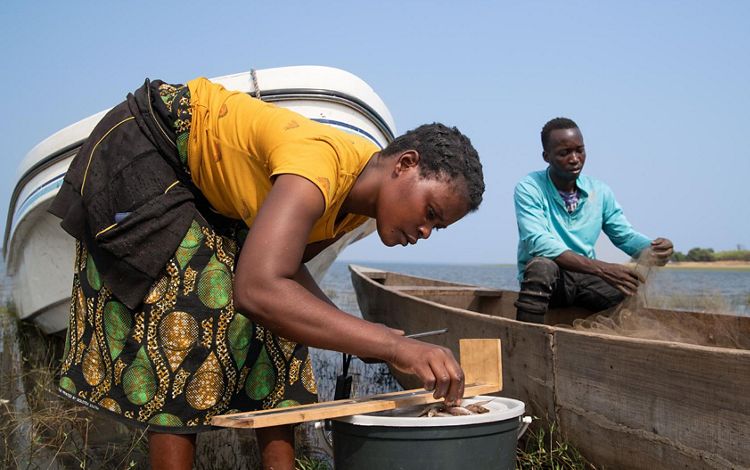
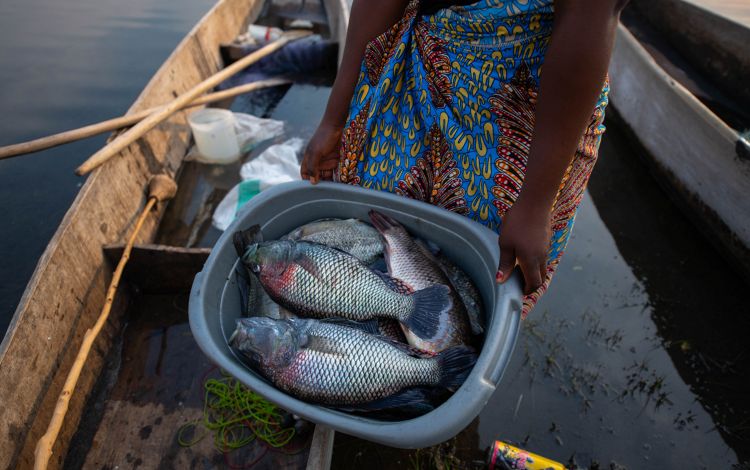
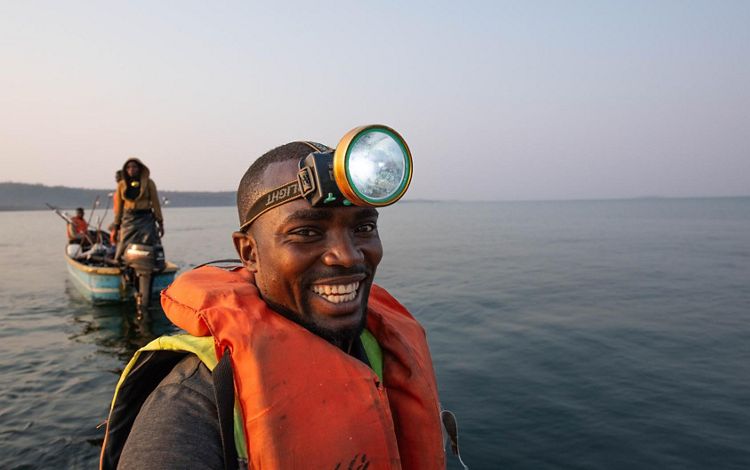
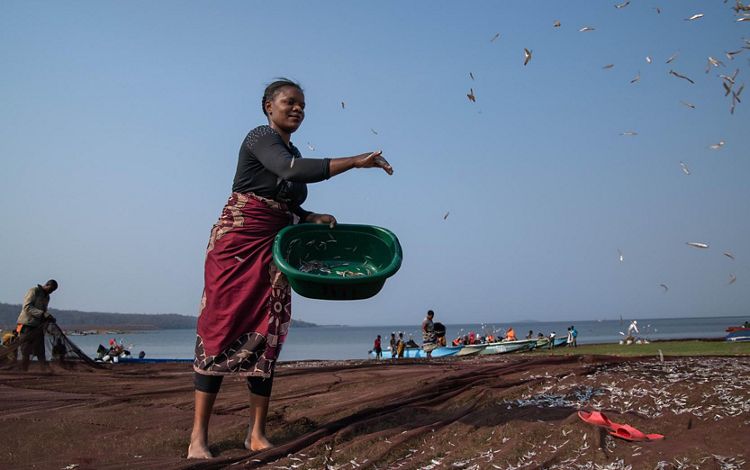
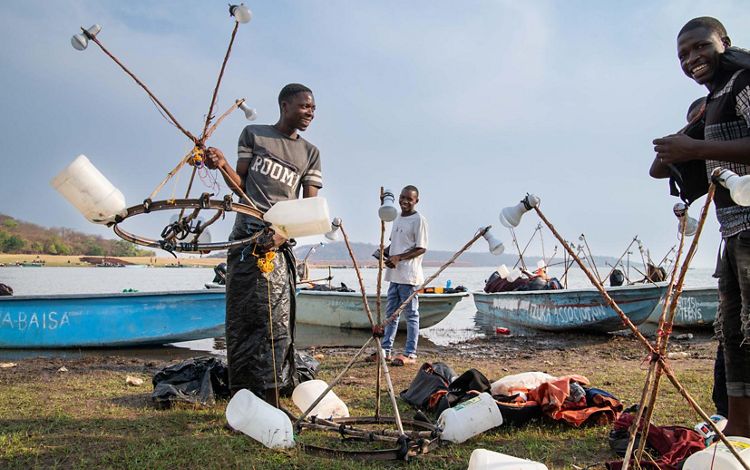
The Challenge
Historically, fisheries across the Kafue-West Lunga Landscape have neither limited the number of fishers nor the volume of fish extracted (open access) which has left many fisheries overexploited. Use of destructive gear has impacted fished species. Unsustainable resource management—including fisheries—and limited economic benefits to communities from conservation activities are top threats to Kafue & West Lunga National Parks and their encircling Game Management Areas. Together, the Park and Game Management Areas comprise a mosaic of conservation areas and sparsely settled communal lands.
The Opportunity
Building on more than a decade of TNC’s community-based conservation experience in this landscape, integrating freshwater targets into existing conservation programs provides an opportunity to enhance community benefits from conservation landscapes. Since 2023, TNC and partners have been developing fisheries baseline data, establishing community-based fisheries governance structures, advancing community co-management rights and community participation in decision-making. Collection of robust socio-ecological data on fishing communities and stakeholders, fisheries governance and management, and fish diversity and distribution are informing fisheries management interventions.
TNC and partners are facilitating a participatory visioning process that will underpin the development of Fisheries Management Plans tailored to meet local community wishes and needs. Next steps will include implementing provisions of the community-owned Fisheries Management Plans and establishing Fisheries Management Units. By equipping these units with capacity building opportunities, data, and rights, local communities can effectively manage and monitor their fisheries. In the future, we plan to investigate options to increase the financial sustainability of emerging Fisheries Management Units and fisheries value chains.
Partnerships in Action
In 2024, TNC signed a Memorandum of Understanding with the Zambia Department of Fisheries. The Kafue fisheries team, which includes TNC and Zambia Department of Fisheries staff, were officially appointed by the Zambian Government to oversee the fisheries management and freshwater conservation sections of the Kafue National Park General Management Plan. This Plan, initiated by African Parks, defines the fisheries management framework within the 2.2-million-hectare Kafue National Park. This is the first time freshwater protection and improved management has explicitly been included in the Kafue National Park General Management Plan process.
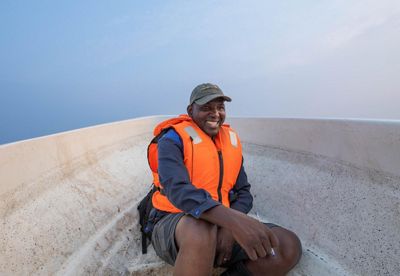
Looking Forward
In Zambia’s Kafue-West Lunga Landscape, we are working toward improved management of 200,000 hectares of lakes and wetlands and 1,000 kilometers of rivers with at least 150 kilometers of new river freshwater ecosystems protected. Through this work, 6,000 fishers will have improved security of rights over fisheries resources and 7,000 people in the fisheries sector have improved sustainable, place-based economic opportunity with more than 30,000 associated direct beneficiaries.
Lake Tanganyika
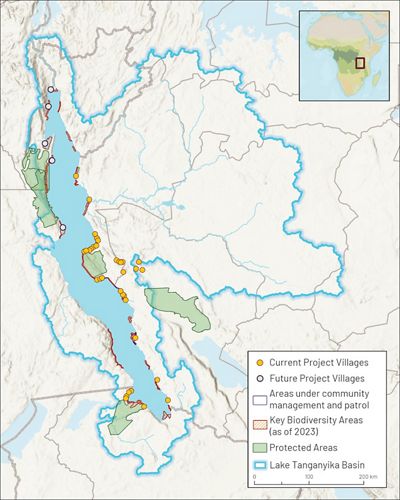
This map highlights current project villages, future project villages, areas under community management and patrol, key biodiversity areas as of 2023, protected areas, and the area of the Lake Tanganyika Basin.
A closer look: Lake Tanganyika
-
- Tanzania
- Zambia
- Burundi
- Democratic Republic of the Congo
-
2012
-
Six endemic fish species (two clupeid sardines and four lates species) make up 95% of the lake’s commercial fishery.
-
- Unsustainable fishing
- Lack of freshwater protection
- Unsustainable aquaculture proposals
- Unsustainable aquarium trade
- Sedimentation from agricultural runoff
- Climate change (adaptation)
-
- Advance community fisheries management
- Provide fishing and agricultural training and support
- Develop lake-wide, community-led monitoring systems
- Empower women and youth in fisheries
- Support new community-led freshwater protections
- Steer caged aquaculture toward sustainability
- Create sustainable finance mechanisms and alternative
-
- Local communities and civil society organizations
- Pathfinder International
- Community Economic Empowerment and Legal Support
- Tongwe Trust
- Education Outreach Tanzania
- Frankfurt Zoological Society
- World Wildlife Fund—Democratic Republic of Congo
- Sustain Lake Tanganyika
- Lake Tanganyika Floating Health Clinic
- Tanzania, Zambia and the Democratic Republic of the Congo government agencies
- Lake Tanganyika Authority
-
- TNC Video: Working in Partnership to Protect the World’s Longest Lake
- TNC Video: Tuungane, 10 Years of Impact
- Maps & Data: Lake Tanganyika Freshwater Atlas
- Tuungane Project: TNC Tanzania projects
- TNC 2022 Article: From Great Lakes to Great Lakes
Uniting to Tackle Overfishing
Situated within Africa’s Rift Valley, Lake Tanganyika is a massive and wildly biodiverse freshwater ecosystem. The region supports over 1,500 plant and animal species, 300 of which are endemic fish. The lake itself holds 17% of Earth’s available fresh water and supports the livelihoods of over 10 million people.
While communities along the shores of Lake Tanganyika—in Tanzania, Zambia, the Democratic Republic of the Congo (DR Congo) and Burundi—have relied on abundant fisheries for generations, growing populations, nearshore land-use changes and overfishing are testing the limits of the lake’s seemingly inexhaustible resources.
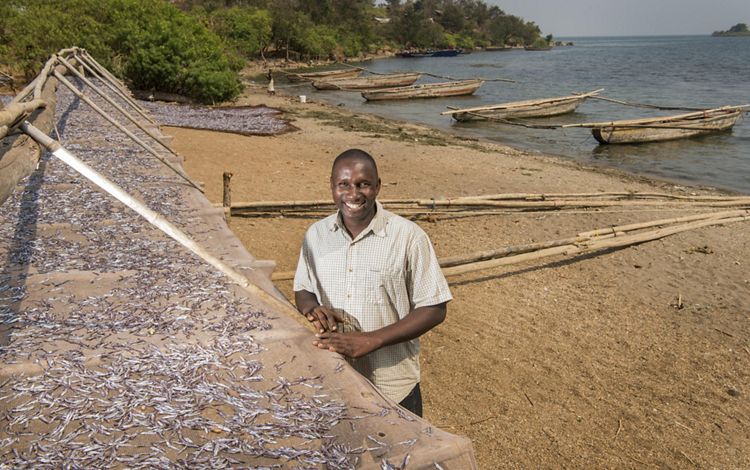
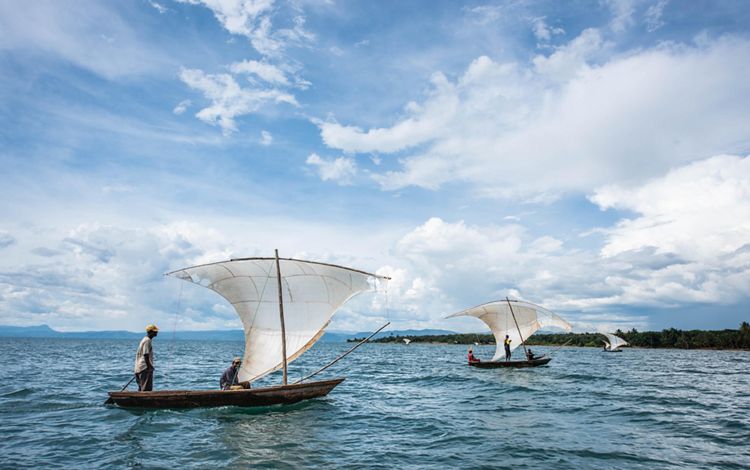
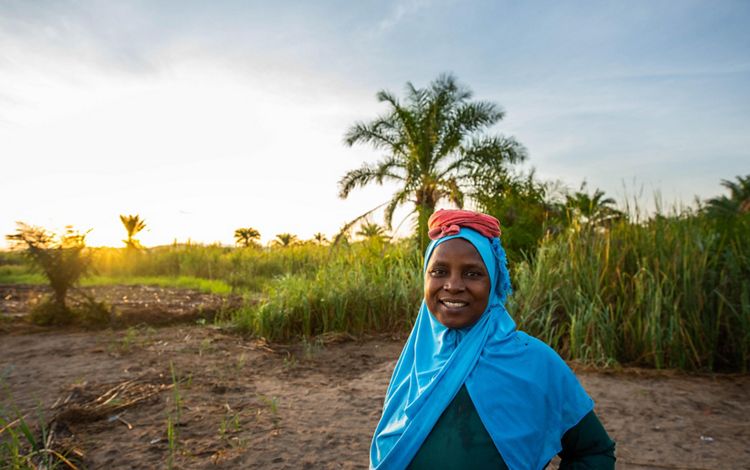
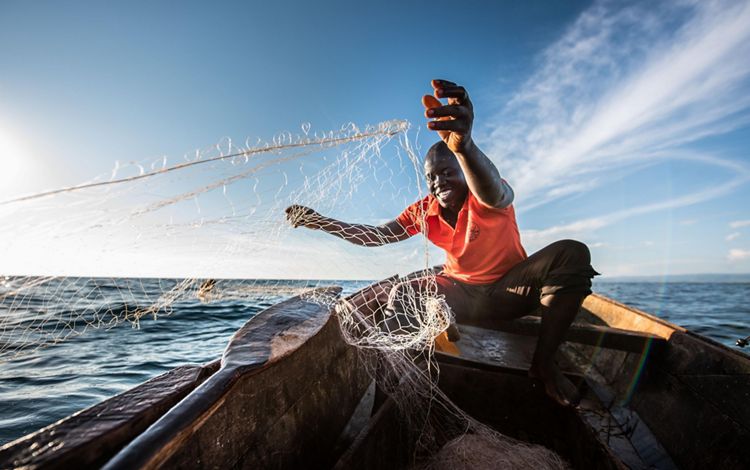
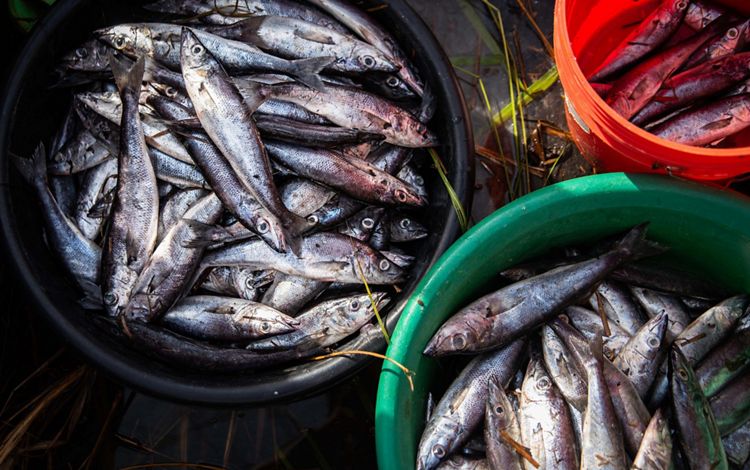
The Challenge
Lake Tanganyika’s fish stocks are declining, compounding already acute rates of poverty and food insecurity.
In addition to climate change, new threats like proposed non-native species aquaculture, aquarium trade and oil and hydropower development projects could push the lake even further into crisis.
The Opportunity
It’s not too late to bring Lake Tanganyika back to abundance. Building on a decade of experience with fishing communities on the Tanzanian lakeshore (through the Tuungane Project), TNC supports the rapid scaling of fisheries best management practices across the entire four-nation basin.

Through our lake-wide program, we work with partners to:
- Create models for effective fisheries co-management, supporting more than 50 community institutions on the lake;
- Design and implement sustainable finance models for long-term funding of conservation outcomes;
- Ensure that caged aquaculture is developed sustainably, without introduction of non-native fish and with adequate monitoring;
- Identify significant freshwater biodiversity areas in all four riparian countries, using the IUCN’s Key Biodiversity Area’s designation; and,
- Maintain a spatial data repository for the entire Lake Tanganyika Basin (for example, see the free and publicly available Lake Tanganyika Freshwater Atlas).
The Local Community in Action
As of 2024, more than 40 lakeshore villages in western Tanzania have established Beach Management Units to enforce sustainable fishing regulations, like outlawing destructive small-mesh nets.
Ten communities have protected and conserved fish populations by securing more than 8,000 hectares of fish reserves, including breeding and nursery sites. More than 20,000 farmers from 16 villages have been trained in climate-smart agriculture techniques that are shown to double crop yields and reduce soil erosion and runoff into the lake.
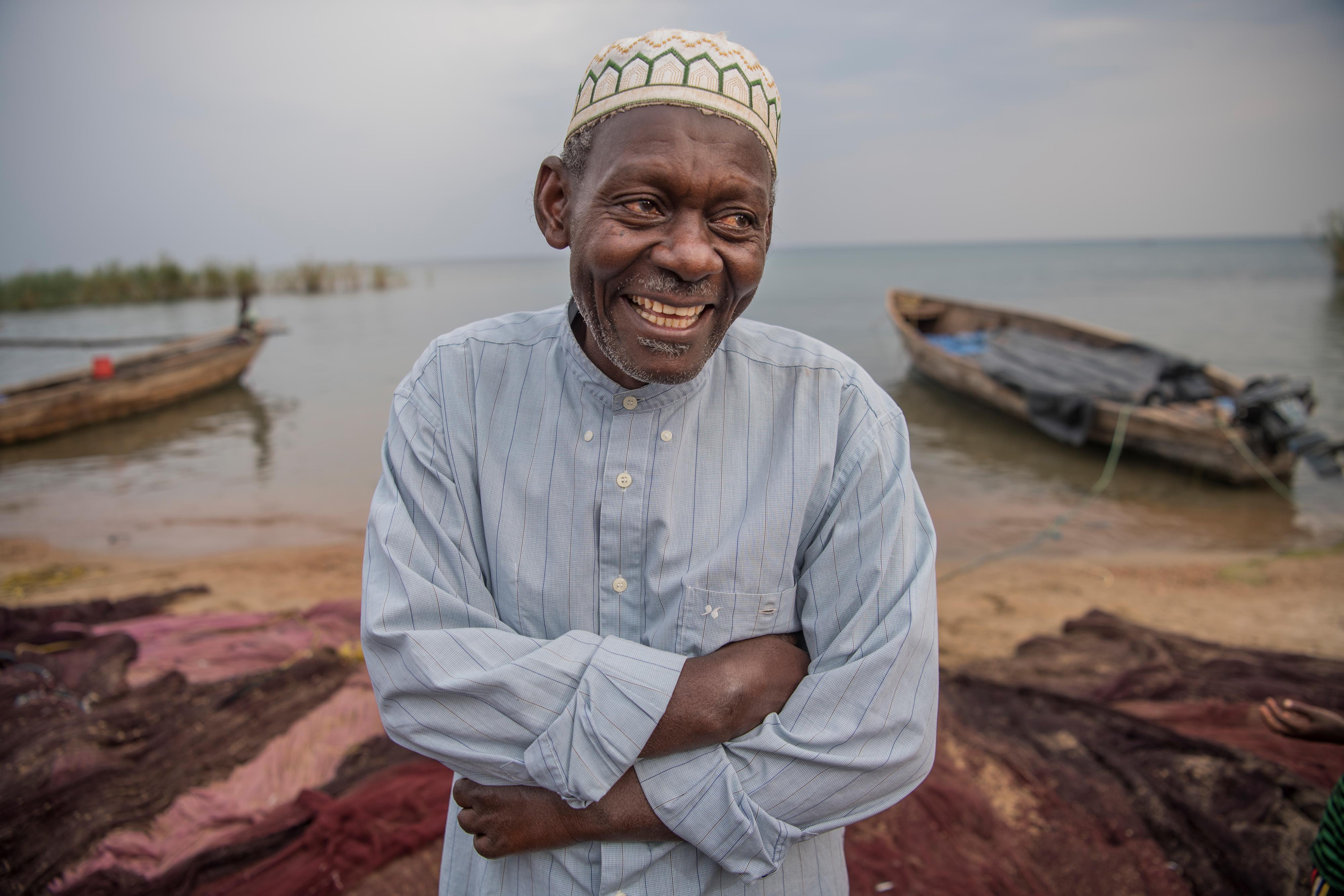
What is a Beach Management Unit?
Beach Management Units (BMUs) are village institutions recognized under national policy, whereby communities co-manage their fisheries with local government. BMUs enforce fisheries regulations, create management plans, collect fisheries data and educate community members on sustainable fishing.
Bakari Itembe is an ambassador for the Tuungane Project and lives in the Katumbi Village. Katumbi villagers were the first to be given a patrol boat for monitoring and model sustainable practices like protecting fish reserves, raising awareness about illegal fishing practices and elevating the voices of women in fisheries conservation.
Looking Forward
TNC will continue to work with civil society, government and community partners to scale proven solutions from the Tuungane Project across all four countries that border Lake Tanganyika. By 2030, we will conserve more than 100,000 hectares of lakes and wetlands and 300 kilometers of river systems throughout the Lake Tanganyika watershed. We will empower more than 170,000 people from local communities to secure rights, improve decision-making over lands, waters, or resources, and/or generate sustainable, place-based economic opportunity.
Bas Ogooué, Gabon
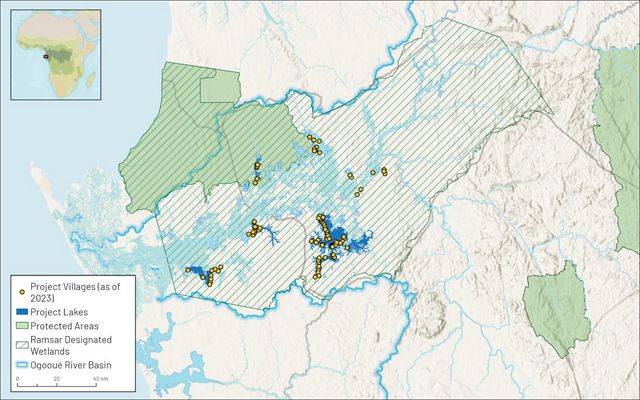
This freshwater fisheries project map in Gabon highlights project villages as of 2023, project lakes, protected areas, and the locations of the Ramsar Designated Wetlands and Ogooué River Basin.
A closer look: Bas Ogooué, Gabon
-
Bas Ogooué freshwater ecosystems | Moyen-Ogooué and Ogooué-Maritime Provinces, Gabon
-
2010
-
Cichlids (tilapia) account for most of the region’s fisheries. Communities also rely on the non-native African arowana, known locally as the “sans-nom” (“no name”).
-
- Overfishing and unsustainable fishing methods
- Lack of alternative livelihoods
- Unsustainable development
-
- Community-led fishery management
- Supporting the development of alternative livelihoods
- Promoting science to improve knowledge and better plan the development of fisheries
-
- Local and traditional communities and organizations
- Organisation Ecologique des Lacs et de l’Ogooué (OELO)
- Department of Fisheries and Aquaculture, Gabon
- National Park Agency, Gabon
- Institut de Recherche en Agronomie Forestière (IRAF)
-
- 2020 Research publication: Mapping Coastal Wetlands of Gabon
- 2022 TNC article: Gabon: Inspiring the World Through Action
- TNC article: Calming a Crowded Lake’s Waters
To Safeguard Fisheries, Empower Local Communities
Straddling the equator on Africa’s Atlantic coast, Gabon is a country of 2.2 million people and seemingly endless nature. Few places in the world rival the intactness of its freshwater systems, which teem with life, including more than 400 described species of freshwater and brackish water fishes.
Gabon’s Bas Ogooué region is no exception. Spanning 1.3 million hectares in the country’s west, it supports a mosaic of free-flowing rivers, lakes and wetlands—which collectively is designated as a Wetland of International Importance (Ramsar Site).
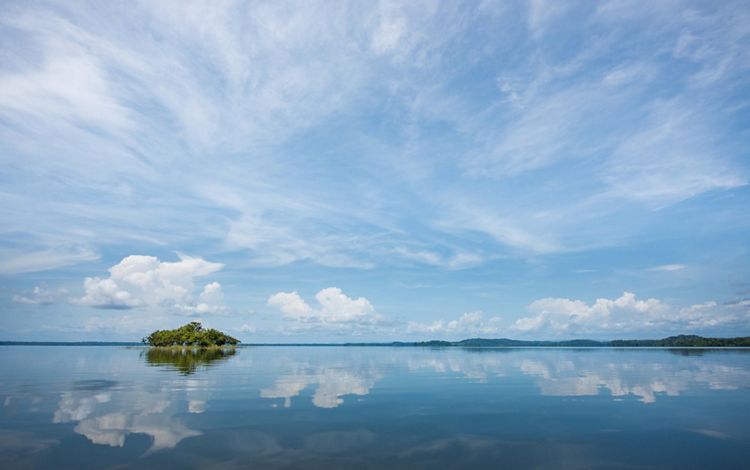
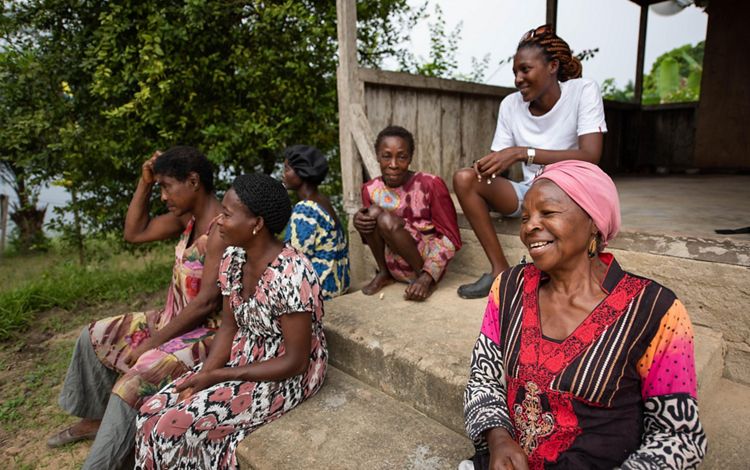
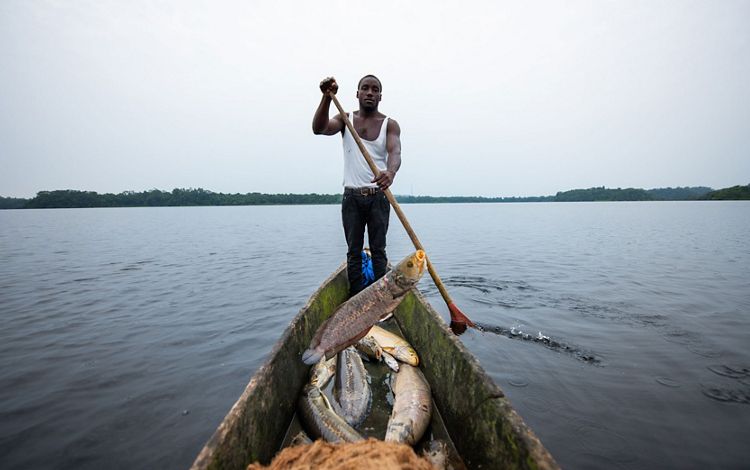
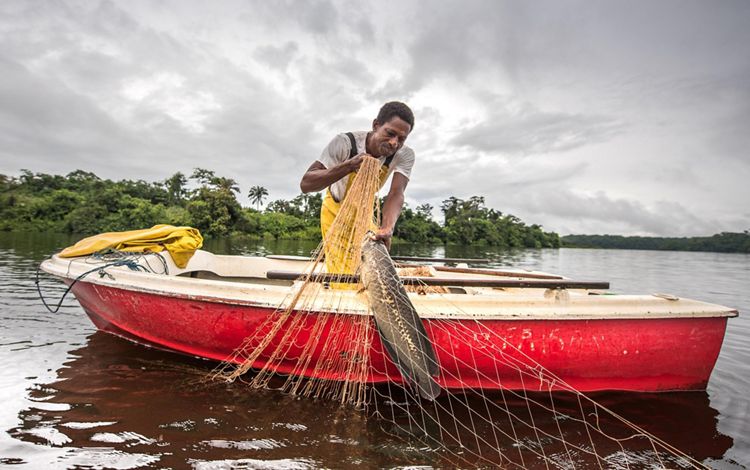
The Challenge
For people living in the Bas Ogooué, fishing is a central part of life and deeply rooted in local culture. In a survey of the communities of Lake Oguemoué conducted by Aquatic Ecosystem Services (AES) and Organisation Ecologique des Lacs et de l’Ogooué (OELO), a local partner of TNC, 100% of households reported fishing as their primary means of subsistence. For these communities, other options for food and income generation have become very limited since small-scale forestry activity has been heavily regulated since 2009.
Unfortunately, unsustainable fishing practices, a lack of economic alternatives and a changing climate are endangering the health of the ecosystem, and so too, the livelihoods of those who depend on it.
The Opportunity
Overfishing in the Bas Ogooué has emerged as a leading problem at the community level. To help, TNC and partners are establishing community-led fisheries management cooperatives and sustainable income diversification options, like agriculture and beekeeping.
In July 2018, Gabon’s national government approved the first community-driven management plan for inland fisheries on Lake Oguemoué. Initiated by Oguemoué fishers and OELO, and supported by TNC, the plan has since become the model for inland fisheries management across the country.
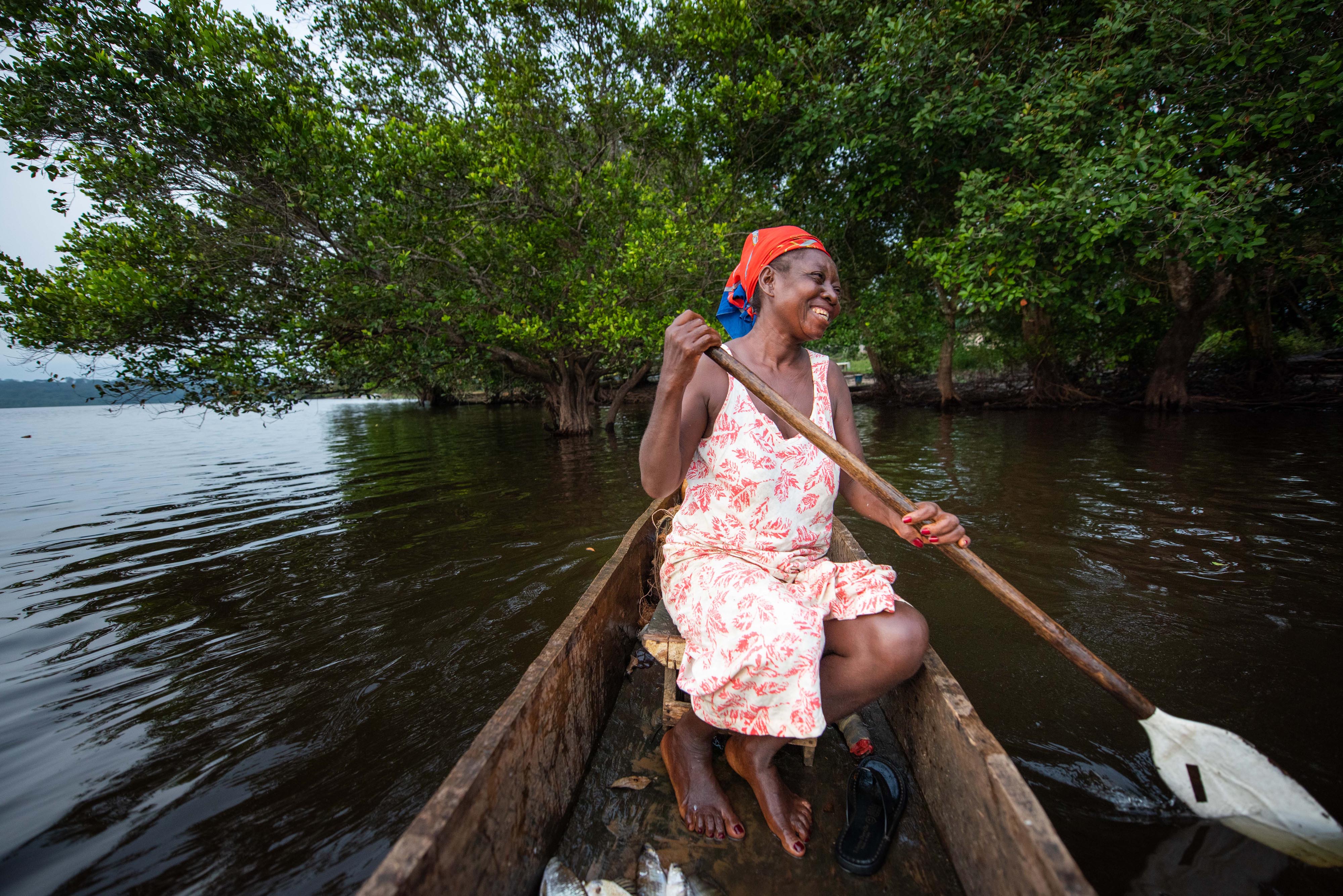
Did you know?
In Gabon, most villages are located near water because water is central to life and the road network is limited. As part of local cultural practices, it is customary to wash your face when arriving at the water to be connected to the good spirits that guard the lake.
The Local Community in Action
Local communities are active in implementing fisheries management plans and serve as a model for replication in communities throughout the country.
TNC’s support helps implement OELO’s “Our Lake, Our Future” initiative to manage lake fisheries sustainably. TNC first partnered with OELO in 2014, but the initiative, community organizing, data collection and government partnerships launched in the years before.
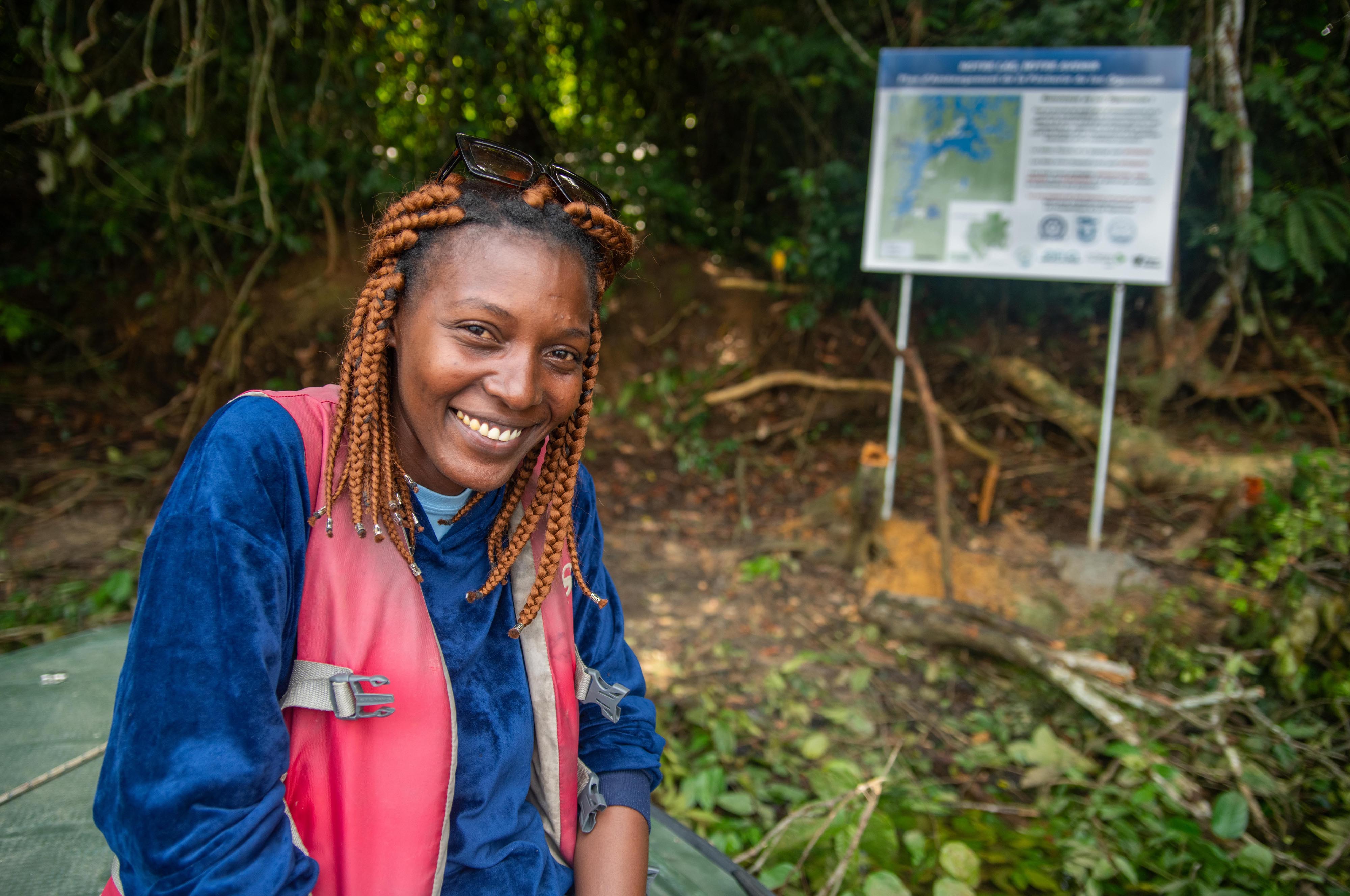
“I believe that nature is the future,” says Rengouwa Maeva, local resident and OELO’s sustainable fishing program coordinator, “because to become self-sufficient, we have to turn to nature.”
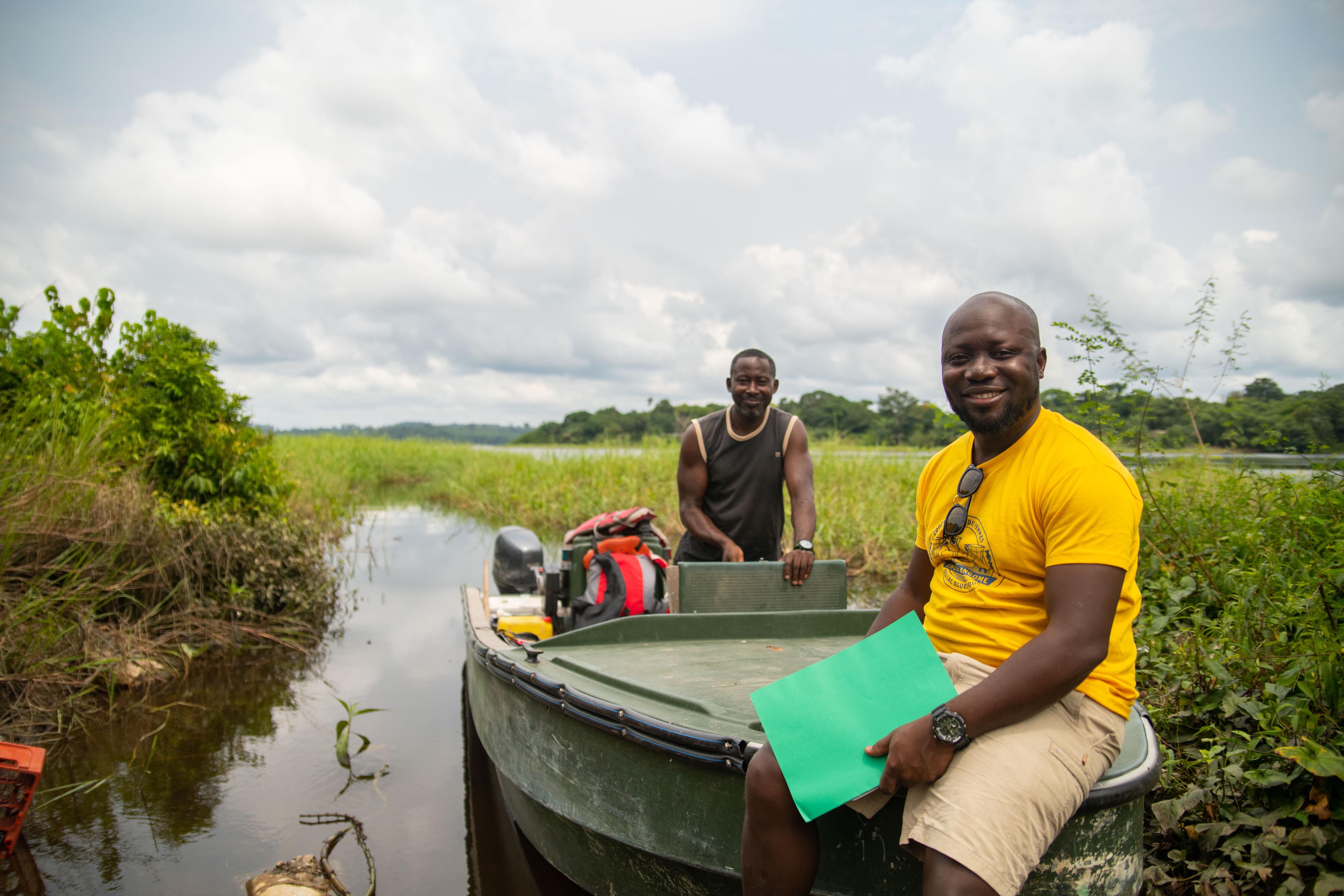
“In Gabon, life is built around water,” explains Jean Churley Manfoumbi (in yellow shirt), manager of TNC’s Community-Led Conservation of Freshwater and Fisheries program in Gabon. “The river provides people with water to quench their thirst and food to eat through fishing.”
Looking Forward
At TNC, our 2030 goals guide our efforts and unite programs across the organization. In the Bas Ogooué region of Gabon, by 2030, we will conserve more than 125,000 hectares of lakes and wetlands and nearly 9,000 kilometers of river systems. We will improve the security rights, decision-making over lands, waters, or resources, and/or the sustainable, place-based economic opportunity for more than 400 people who are sustained by the Bas Ogooué region.


